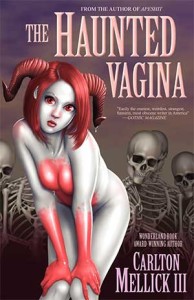 Let’s first judge the novella The Haunted Vagina by Carlton Mellick III (Eraserhead Press, 2006) by its cover, as I believe we’re supposed to. There’s a naked, computer-graphic woman with horns on her head and red stains on her body. She stands in front of computer-graphic skeletons arranged with artist Ed Mironiuk’s repeated use of copy and paste.
Let’s first judge the novella The Haunted Vagina by Carlton Mellick III (Eraserhead Press, 2006) by its cover, as I believe we’re supposed to. There’s a naked, computer-graphic woman with horns on her head and red stains on her body. She stands in front of computer-graphic skeletons arranged with artist Ed Mironiuk’s repeated use of copy and paste.
Then there’s the title. Say it with me: The Haunted Vagina. “From the Author of Apeshit.”
When we open the book, there’s an author’s note, “I miss Andre the Giant.” It has nothing to do with the story.
And the author photo on page 91. Mellick is a strange-looking dude with a shaved head, horn-rimmed glasses, mutton-chop sideburns, and a goofy facial expression. However, you have to give him props for making fun of author photo convention by thoughtfully stroking his chin. There’s so many photos out there where folks affectatiously stroke or support their chin à la The Thinker that I want to vomit. That might make a good bizarro fiction story, by the way: “Stroke Your Chin So I’ll Vomit.”
 And the use of the word “bizarro” to label the genre. Bizarro is a sixteen-year-old experimental movement in speculative fiction that emphasizes absurdism. Since it mostly revolves around Eraserhead Press in Portland, Oregon, the label might actually be a marketing gimmick rather than a scholarly genre theory. (Then again, aren’t all genre labels, at their core, marketing gimmicks?) It’s not necessarily a new thing, either. Writing that calls itself weird dates back at least as far as the classic Weird Tales magazine.
And the use of the word “bizarro” to label the genre. Bizarro is a sixteen-year-old experimental movement in speculative fiction that emphasizes absurdism. Since it mostly revolves around Eraserhead Press in Portland, Oregon, the label might actually be a marketing gimmick rather than a scholarly genre theory. (Then again, aren’t all genre labels, at their core, marketing gimmicks?) It’s not necessarily a new thing, either. Writing that calls itself weird dates back at least as far as the classic Weird Tales magazine.
In any case, none of this packaging gives the impression of a high-brow read. Not that it’s supposed to. Maybe it’s supposed to offend us and make us laugh at the same time.
Still, the reader thinks, It’ll probably be a fun read. And it turns out you’re right. The opening line is, “I’ve been scared to have sex with Stacy ever since I discovered her vagina was haunted.” Our narrator, Steve, goes on to tell us that whenever he puts his ear against Stacy’s crotch, “It was like listening to the ocean in a hairy flesh seashell.”
It gets stranger and funnier from there. One night, while they’re having sex, Stacy suddenly gives birth to a fully grown, animated, human skeleton. Steve brains it with a lamp, thankfully. Then when they discover Stacy’s vagina is actually a gateway to another world, Steve goes spelunking, gynecologically speaking. He completely crawls inside his girlfriend to enter a surreal Oz where he meets the skeletons and aforementioned horned (and, as it turns out, horny) girl.
Silly? Sure. Offensive? Depends who you ask.
But is it good writing?
Here’s What’s Unexpected
Yes. It’s good writing. Mellick practices a clean, spare technique. It’s an easy-to-follow style with an emphasis on action, good dialogue, and good characterization. As a writer, I know that’s no mean feat. To make something easy to read and seem as if it was easy to write is quite hard.
I wasn’t expecting to read a sweet love story. Steve and Stacy are dysfunctional twenty-somethings who meet at a bus stop. They sleep together, literally, for three weeks before so much as kissing. Stacy enjoys stuffed grape leaves, Russian films, and playing music at open mics. Steve loves IPA beers and is so impulsive that he’ll give his $200 coat to a homeless man. Stacy licks her glasses clean before she reads and calls water pouring out of faucets waterfalls.
That Steve would, after battling the skeleton, not only not desert his girlfriend but agree to explore her supernaturally dangerous uterus feels like a natural outgrowth of that love. Despite the patent absurdity of the situation, the characters don’t behave inconsistently with their characterizations.
This makes sense when you read on Mellick’s Amazon author page that “his current style is to take the most ridiculous concepts imaginable and approach them with complete sincerity, as if they are not intended to be ridiculous at all.”
Which brings us back to the book’s sales presentation. Why be self-consciously ridiculous and offensive? I wonder if bizarro authors secretly share similar goals with Marilyn Manson. During Manson’s interview by a confrontational Bill O’Reilly, the musician said his Satanic imagery and costuming is all about shocking his audience. He wants them to re-think ideas they may have taken for granted. For instance, Manson says, has it ever occurred to people to contemplate the image of a crucifix purely as an image, apart from its theological meaning? “People can look at Christ on a cross and think this is an image of murder. This is violent. This has sexual imagery in it. I think it’s my job as an artist to be out there pushing people’s buttons and making them question everything.”
Is that really what writers like Carlton Mellick are doing? He says no. “It’s weird when people assume I’m trying to shock or offend readers,” Mellick stated in an interview with Musique Machine.
Oh, really?
“I’m shooting for being interesting or funny. I’m also trying to write stories that have never been written before. The reason why I might sometimes journey into taboo territory at times is because it’s territory that’s mostly unexplored. The easiest way to write something that nobody else has written before would be to write something that nobody else would dare write.”
Except, This is Really Just Old Hat with a New Hat Band
The thing is, the ideas in The Haunted Vagina aren’t unexplored, as Mellick claims. When you strip away the grotesqueries, it’s a conventional fantasy story.
Lewis Carroll used gateways into a surreal world in Alice in Wonderland and Through the Looking Glass. That Mellick’s gateway is human body rather than a mirror is no more ridiculous than the premise of the film “Being John Malkovich,” in which people crawl through a magic door to physically enter the mind of actor John Malkovich for fifteen minutes before materializing in a ditch near the New Jersey Turnpike. Substitute C.S. Lewis’s enchanted wardrobe for the vagina, and this could be any other fantasy story. Further, the story’s action, what with the animated skeletons who bleed blue ink, is no more out there than the “Evil Dead” movies.
So then, what is “bizarro,” assuming The Haunted Vagina is a good example of it? Is bizarro just Spongebob Squarepants dressed up as Marilyn Manson? No, not in this case. The novella isn’t written entirely in a comedic tone, notwithstanding Mellick’s stated goal to be funny.
 Maybe bizarro isn’t comedy, then. Maybe it’s just trying to be bizarre. But is it really so bizarre? David Lynch’s seminal 1977 movie “Eraserhead,” eponym of Mellick’s publisher Eraserhead Press, is genuinely bizarre. It’s a disturbing, trippy portrayal of a man’s disastrous entry into fatherhood. The movie makes no sense until you realize everything in it is symbolic. For example, the chipmunk-faced Lady In the Radiator, who smiles as she squishes giant sperm underfoot, symbolizes Henry Spencer’s mindspace of sexual fantasy. The film tells the story of Spencer trying to care for, and ultimately murdering, his infant child. That the baby is depicted as a repulsive, mewling dog fetus doesn’t diminish the viewer’s outrage at Spencer’s final act. The film’s use of bizarre imagery and sound design are intended to heighten that emotional effect.
Maybe bizarro isn’t comedy, then. Maybe it’s just trying to be bizarre. But is it really so bizarre? David Lynch’s seminal 1977 movie “Eraserhead,” eponym of Mellick’s publisher Eraserhead Press, is genuinely bizarre. It’s a disturbing, trippy portrayal of a man’s disastrous entry into fatherhood. The movie makes no sense until you realize everything in it is symbolic. For example, the chipmunk-faced Lady In the Radiator, who smiles as she squishes giant sperm underfoot, symbolizes Henry Spencer’s mindspace of sexual fantasy. The film tells the story of Spencer trying to care for, and ultimately murdering, his infant child. That the baby is depicted as a repulsive, mewling dog fetus doesn’t diminish the viewer’s outrage at Spencer’s final act. The film’s use of bizarre imagery and sound design are intended to heighten that emotional effect.
If that’s archetypal bizarro, then The Haunted Vagina, as entertaining as it is, has no correlation. Its absurdist imagery doesn’t enhance Steve and Stacy’s sincere love story, except maybe as a half-hearted attempt to evoke a visceral male fear of females. When Steve is trapped inside the microcosmic world inside Stacy’s uterus, he’s as effectively emasculated as Aoyama in the Japanese horror movie “Audition” when his actress girlfriend cuts off his foot with piano wire. But I’m stretching to make such a claim. Whereas that scene is truly horrifying, especially to a male-dominated Japanese audience, Steve’s nearly suffocating inside Stacy’s birth canal is a big what-ev.
If The Haunted Vagina is a good example of contemporary bizarro, then my theory is that the only thing distinguishing bizarro from other fiction is its packaging and choice of subject matter. If my novella No Outlet were retitled to No Anus, the M.C. Escher-esque shopping mall escalators on the cover replaced with intestines, and the story changed from shoppers trapped in a supernaturally maze-like shopping mall to “Fantastic Voyage”-like microscopic whitewater rafters floating down an endless river of shit, would that make it a bizarro title? It just might.
Where I Wish Carlton Mellick Would Go
I think The Haunted Vagina’s absurdism and deliberately offensive presentation detracts from what is otherwise a great story. Mellick has the chops to easily reach a more mainstream audience, if he cared to.
I’m going to go out on a limb here (as if I’m not already) and suggest Mellick would be better served by tamer cover art than slapdash B-horror imagery or potentially revolting images like the first cover of Satan Burger. Take for example the 2005 case of Jared Armstrong of Girdwood, Alaska, who was charged with a sex crime for giving Satan Burger to a minor. As Mellick recounted to Musique Machine, “I guess they thought the guy was a pervert or something, probably due to the fact that the cover of the novel features a woman’s naked butt squatting over a dinner plate.”
He might also try writing full-length novels more often. He claims on his FAQ page that his stories are more suited to novella length, especially since “I want my books to have more of a juvenile/young adult lit feel to them.” But The Haunted Vagina is a good example of why novellas can’t always fully develop a good idea. I’m thinking specifically of Steve’s abrupt character arc at the end from feeling ambivalent toward his horned captor, Fig, to being wildly in love with her. It happens across the course of only two pages. Sure, Steve spans a good bit of narrative time with this jump, and he even speculates his feelings toward Fig are byproducts of Fig’s genetic manipulation of him. But this doesn’t alleviate the reader’s impression of abruptness. The world’s best stories are all about character change, after all. I would say that’s the whole point. And a profound change like this deserves more than a few pages. If Mellick had written a longer story, one in which he more thoroughly explored the mythology he only hinted at, then that character arc might have had time to feel more believable.
I would like mainstream readers to get past Mellick’s presentation to experience what I read: a damn good fantasy story, written in just the right tone to make a point about the nature of love. (The Haunted Vagina would have been a pretentious disaster without at least a seasoning of humor.) I’m looking forward to reading his newest offering, As She Stabbed Me Gently in the Face, about a serial killer in a monogamous homicidal relationship with an immortal, sociopathically possessive masochist. As the dustjacket unnecessarily spells out, the story is a metaphor for a bad relationship, kind of like the bunny stew in “Fatal Attraction.”
Now, if you’ll excuse me, I’m off to read more Carlton Mellick.


2 Responses
Matt: Try Mellick’s novel QUICKSAND HOUSE. A bit lengthier and a bit more in line with what you’re looking for, I think. Certainly one I consider to be among his best.
Thanks, I will.